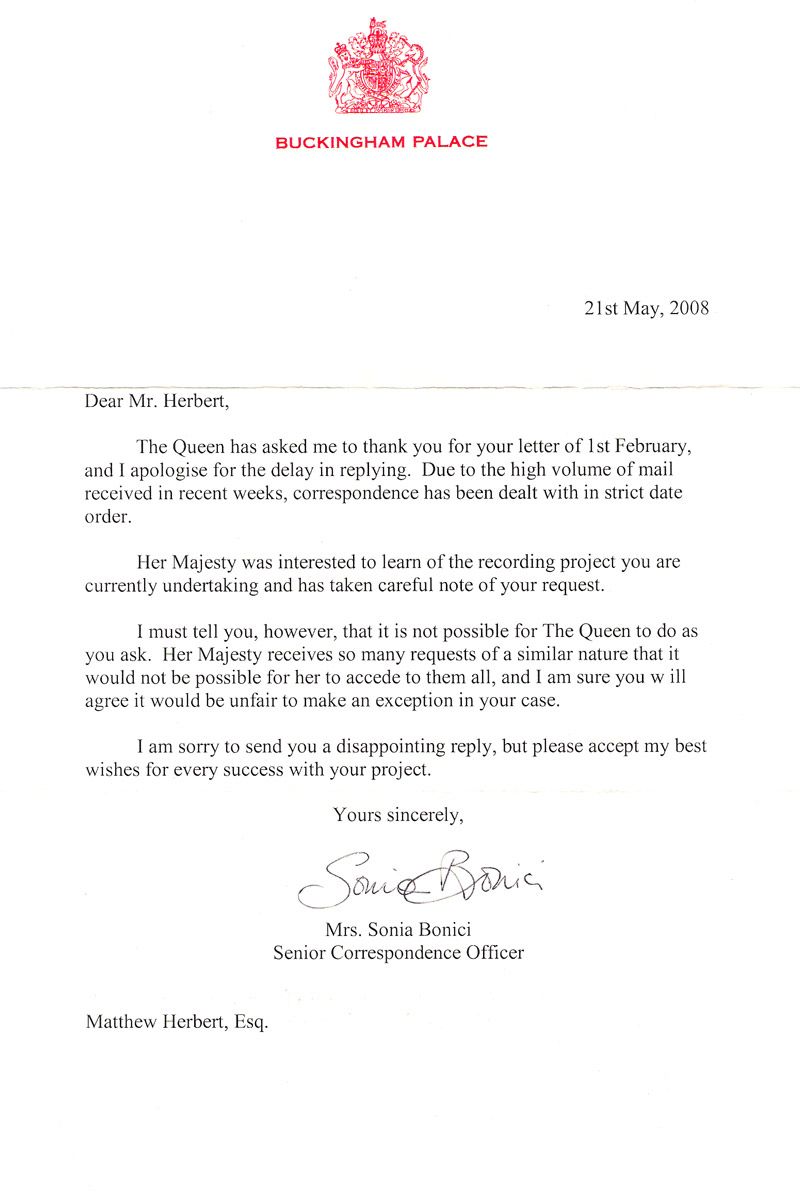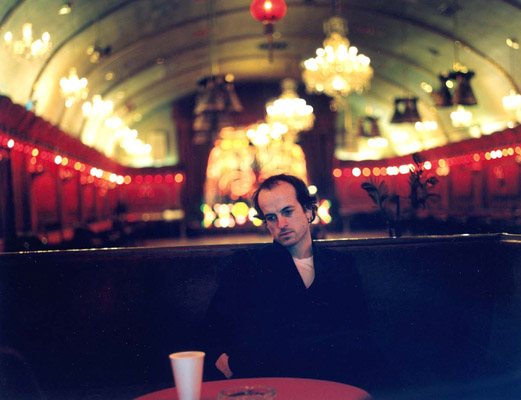Matthew Hebert is dressed casually in shorts and a short-sleeved shirt but somehow manages to make it seem as elegant as the tuxedo he wears on stage when working with his Big Band. The new album, There’s Me and There’s You, the second release as the Matthew Herbert Big Band is a hugely ambitious work- fiercely and morally focussed taking in power, corruption, lies and love amongst the way journeying from the Houses of Parliament to Palestinian farmers’ fields.
How long did it take to put the album together?
"The record itself took about 2 years to make and the first year of that is spent on research and planning whilst the first 6 months of the second year is spent on the arrangements for the big band with my arranger Pete Drayton. I write the music and send it to him and then he sends it back to me and it goes back and forth and we compare notes on textures and harmonisation and tempo and structure and then we record and in this case we record in a day."
A Day?!
(Laughs) "Well, that’s because we’ve had 6 months of solid work beforehand and professional and I’m working with a professional arranger as are the players and hopefully by now I’m professional in what I do too so…"
I guess there must be logistical reasons too?
"Well of course and also I pay for everything myself as well, the entire recording. For example, there’s one piece of music called ‘Just Swing’ which is an ironic nod back to more glamorised big band swing and if that had been recorded normally we would have just worked on that one track for one day so its not ideal but it creates a certain kind of intenseness which I do like."
How about the other participants?
"We asked 100 volunteers to come to the British museum and 70 turned up and that was like democracy in action (laughs) and I was thrilled that so many turned up and that was an evening’s recording and then we had a 28 strong choir and some tracks have up to 400 people contributing to it and that has to be condensed into 5 minutes. And the final piece is recording the vocals with Eska (Mtungwazi), which can take up to 2 months so that’s the whole process really. The record basically ends up as 18 piece big band – 5 saxophones, 4 trumpets, 4 trombones, a rhythm section, a choir of 30. That’s 70 people making sounds – an orchestra of noise I call them – plus Eska and the backing vocalists and all the field recordings I’ve made separately. So, this record went in to the house of parliament, McDonalds in Kensington, landfill sites and so on."
A rarity amongst practitioners of electronic music (a genre which he only loosely fits into) Herbert often deals with hidden political and global situations and issues, sometimes (as in this case) across an entire album. What are the themes then to There’s Me and There’s You?
"Initially I wanted to make the school about an institution so I was going to go to a school at the bottom of the league table and make an album out of the fabric of the building like the radiators, the doors, the corridors and then use the people inside like the children and the teachers cos I wanted to make a political point about worth and value. However, I realised that there’s too many hardworking teachers and pupils and so much effort spent in trying to locate schools and make them better so I decided to shift my attention to an institution that was more destructive. I was going to use my local Tesco’s but then I thought if I wanted to make a viable political statement in a way that was impossible for people to describe in an way other than political then I would have to go into the Houses of Parliament! I asked if I could go in and they were quite friendly- it’s quiet an arbitrary way to get in: you have to presented by a member and some were helpful, some were not but soon a year passed and I had to start making the record. So I started looking at things had gone wrong like the war in Iraq, torture, consumption, advertising, the media and all those kinds of things. And it then became about power in some description but I widened it to look at religion and love and communication and not just negative connotations of power."
Maybe it’s worth breaking down an individual track to just to show the level of analysis and thought and the extraordinary amount of sonic detail that goes into one song. Let’s taking opening track The Story that has the lyrical refrain of "read nothing about it". How does that break down then?
"It’s about the media and the vacuousness of large sections of the media and just how happy it is to chase that elusive capitalist dream of popularity and the money that comes with that. So, vast amounts of people will know about Britney Spears’ knickers or lack of them but nobody will know about the North American free trade agreement and the effect it’s had on Mexican farmers. Now, I know that sounds incredibly dry and to be honest I’m not entirely surprised that people choose knickers over free trade agreements but the media, or at least in my understanding of it, isn’t there to make judgements on what they think we explicitly want to be interested in. It should be there to bring a clear democratic approach to information whereby things that involve the greatest number of people are given a greater priority. So consequently, something like the price of Mexican corn was flattened as soon as America dumped its subsidised corn in Mexico, bringing vast numbers of farmers to bankruptcy and raising the price of corn and tortilla’s which are the national dish. This is of such huge importance to huge numbers of people and yet it’s entirely absent from things like Murdoch’s media in any meaningful sense, and on top of that its missing from the NME, from Wallpaper magazine, from Madonna’s body of work."
How do you deal with this in sound then?
"Well, these are all things that are in there. The first sound you hear sounds like a gunshot but its actually 70 people slapping a copy of Heat magazine against their things in the British museum and so it has this huge amount of reverb on it. There’s me destroying a Madonna CD (makes a crinkling sound) and there’s another noise which is me blowing through the NME (makes a very attractive whooshing sound) and the kick drum is made from Wallpaper magazine. You also have everybody ripping up a copy of The Sun so this fleshes out the story and what you have are people pointing musical fingers. I feel that we live inside an illusion and there’s an awful lot of people investing an awful amount of time sustaining that illusion and music is one of them. Of course its not just the NME and its not just Wallpaper out of the style magazines and even though it might not be their responsibility to talk about torture in Abu Ghraib or tortilla prices in Mexico… What I would hope is that there would be an even spread across the media that would maybe have a moral standpoint on this kind of thing. Yet, instead, it’s happy to contribute to the illusion and sell £1,000 pair of jeans or a £50,000 handbag or what Kate Moss happens to be wearing this week and this kind of thing obscures the world. By ignoring big stories like this it’s almost like a crime of omission and if you look across the British media over the last 50 years you would really have no sense of what had been going on across the world."
Why Big Band?
"In my work I try to find different ways to amplify the same or similar stories that I think are important and these are relatively consistent and they’re about over-consumption for example. Coffee for instance has a historical narrative and a violent present and the more disposable it is the darker it tends to be. So, I want to try to draw attention to coffee and the Vietnam War. There’s a very direct link and Vietnamese coffee farmers came on to the market and flooded the world market with IMF loans and one of the reasons that Vietnam is growing coffee is because of the defoliation caused by agent orange and so I’m looking to transform the everyday.
If you look at the big band record then its 30% big band harmonic and melodic contribution and 30% sound and political and then about 30% vocals and lyrics which are telling the story and then 10% electronics and stylistic things. On ‘Plat du Jour’ for instance, you immediately remove the lyrical and vocal factor and you shrink the harmonic potential by using cups and saucers and grains of sugar to make melodies out of. It is a lot of work and not very rewarding. ‘Plat du Jour’ was almost 98% made from food, and you are trying to compete with Duke Ellington – or Robbie Williams for that matter – with a grain of sugar or a packet of crisps. So working with the big band gives me the opportunity to react harmonically and melodically express these stories and react emotionally and you can seduce people with its familiarity and then afterwards you find out that you’ve been listening to the sound of cremation. So that ability of transformation is very different whereas in ‘Plat du Jour’ you immediately know what its about and why."
What about your encounter with the Queen then?
"Oh, that’s on the track Yessness. I contacted people of power and I wanted 100 people to just say yes. It’s basic GCSE stuff you know, so I wrote to the Queen and Gordon Brown and also asked my neighbours and friends so that it would be a unifying and democratic principle – so the yes from a self-help guru is so different to the yes of the United Nations in sanctioning the war on Iraq so really I wanted to just re-democratise that effectively. Of course the Queen never said yes but it was funny as it she doesn’t even manage to say no rather that it’s just not possible for her to do it and she apologises for sending what must be a disappointing letter."

We laugh at the Queen mulling over whether to do the new Herbert record or not.
"Well, I’ve licked a few stamps with her head on it so that should be the least she can do."
I agree wholeheartedly, a stint with the genial maverick could do nothing but the world of good.
Check out the man’s suitably apocalyptic website at Accidental Records.



